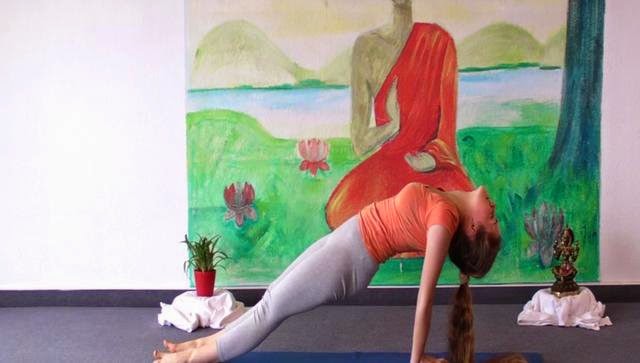Yoga For Complete Beginners – 20 Minutes Yoga Class + Video
 By Jenny Hills
By Jenny Hills
Yoga is an ancient spiritual science that combines philosophical teaching with physical and mental practices. It originates in India, where it was first mentioned in The Vedas – the sacred text dating back to 500 BCE. The beginnings of Yoga pre-date this text, as it was developed by the Indus-Sarasvati civilization over 5000 years BCE.
Below you can find a 20 minutes yoga class for complete beginners. You can also read my article about 10 yoga poses to make you feel fantastic in 15 minutes (including illustrations).
Widget not in any sidebars
Yoga was brought to the West by the Indian gurus in the late 19th and early 20th century, where it was eagerly embraced for its health, emotional and spiritual benefits.
There are many different styles of yoga, some more physical than others. The most well known types include Hatha, Ashtanga, Kundalini, Raja and Tantric yoga. People usually choose one depending on their needs, physical abilities and preferences.
Yoga is often associated with a set of postures (or asanas), but there is much more to it, including the specific theory about the human physiology, which involves the study of energy channels and energy centers or chakras.
To better understand the physical and psychological benefits it brings, yoga has been widely studied and is sometimes recognized as a form of alternative therapy.
What happens in the body when you do yoga could be describes in the following way (using Western/medical terminology):
We have two types of autonomic nervous system: the sympathetic nervous system (SNS) and the parasympathetic nervous system (PNS). The first is responsible for the fight or flight reaction, while the latter deals with the rest and digestsetting of the body. In other words, the SNS concerns stress, while the PNS is all about relaxation. In these busy, competitive, demanding and alienating times, the SNS is the one working overtime, while the PNS doesn’t get activated as often as it should, if we are to have a balanced body and mind.
 When you do yoga, the PNS gets woken up, which results in the blissful feelings of relaxation. Physiologically speaking, the PNS lowers blood pressure, slows the heart rate and redirects blood toward the digestive system. Basically, it takes care of those parts of the body which are neglected when the SNS is in charge.
When you do yoga, the PNS gets woken up, which results in the blissful feelings of relaxation. Physiologically speaking, the PNS lowers blood pressure, slows the heart rate and redirects blood toward the digestive system. Basically, it takes care of those parts of the body which are neglected when the SNS is in charge.
Some yoga practices activate the PNS directly, as is the case with the more gentle postures and deep diaphragmatic breathing (also known as pranayama). More energetic styles and physically demanding postures might initially stimulate the SNS, but if the practice finishes off with a meditation, they eventually bring a deep state of relaxation.
Yoga has been used to:
- Improve mood and reduce anxiety.
- Improve heart health and symptoms of heart failure.
- Help with back pain.
- Reduce high blood pressure.
- Improve joint mobility and build strength and flexibility.
- Improve posture and help with some musculoskeletal conditions.
- Help with asthma and allergy symptoms.
- Reduce stress.
Yoga has also been used with cancer patients and people suffering from schizophrenia, mostly to help with symptom control and improve their quality of life.
To start, you will need some discipline and inspiration, but it is a very rewarding practice, so have a go!
Resources:
http://www.collective-evolution.com/2014/02/26/yoga-for-complete-beginners-a-yoga-class-in-20-minutes/
http://www.yogabasics.com/learn/history-of-yoga/
http://healthyliving.azcentral.com/benefits-yoga-parasympathetic-nervous-system-1519.html
This article first appeared at Healthy and Natural World




